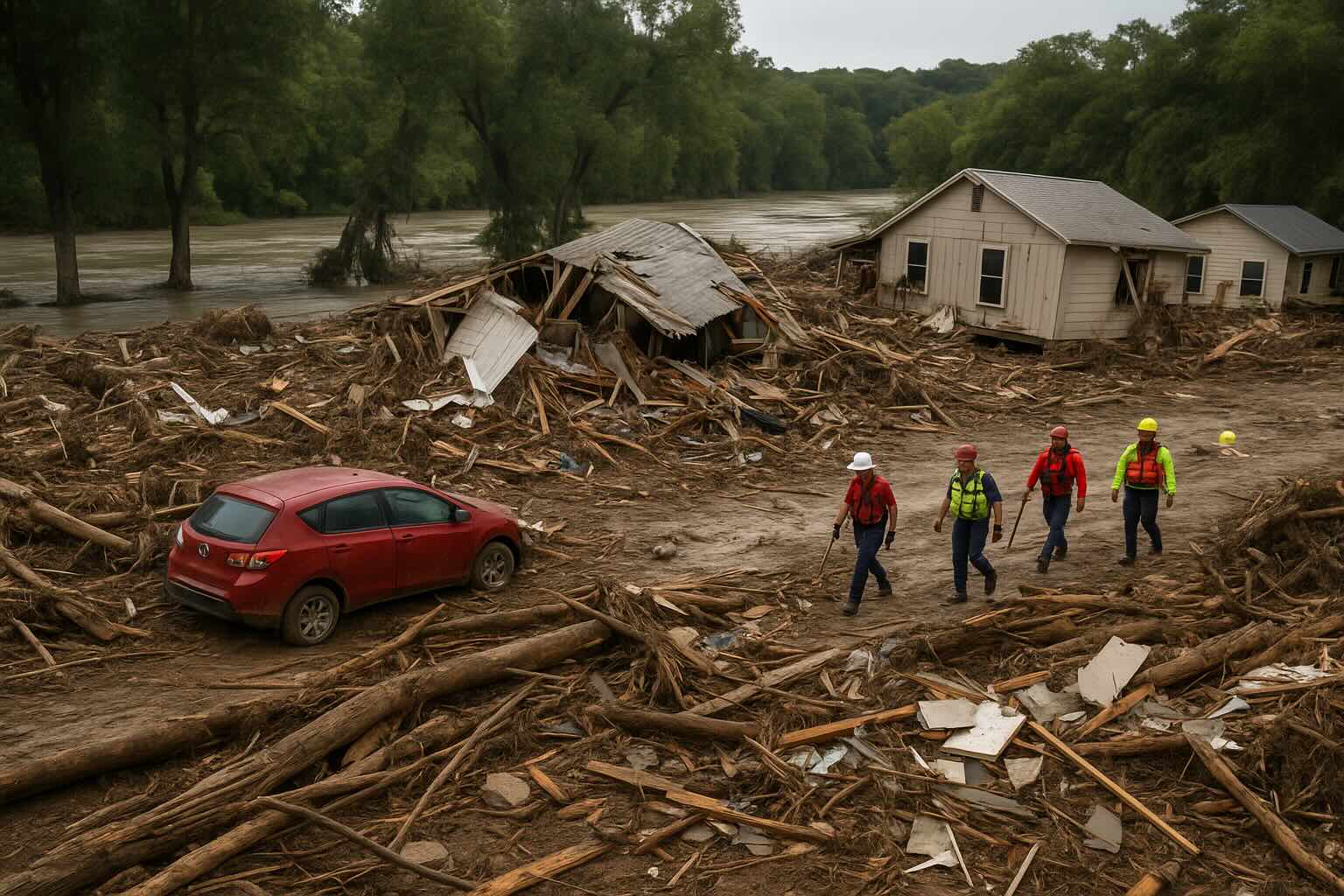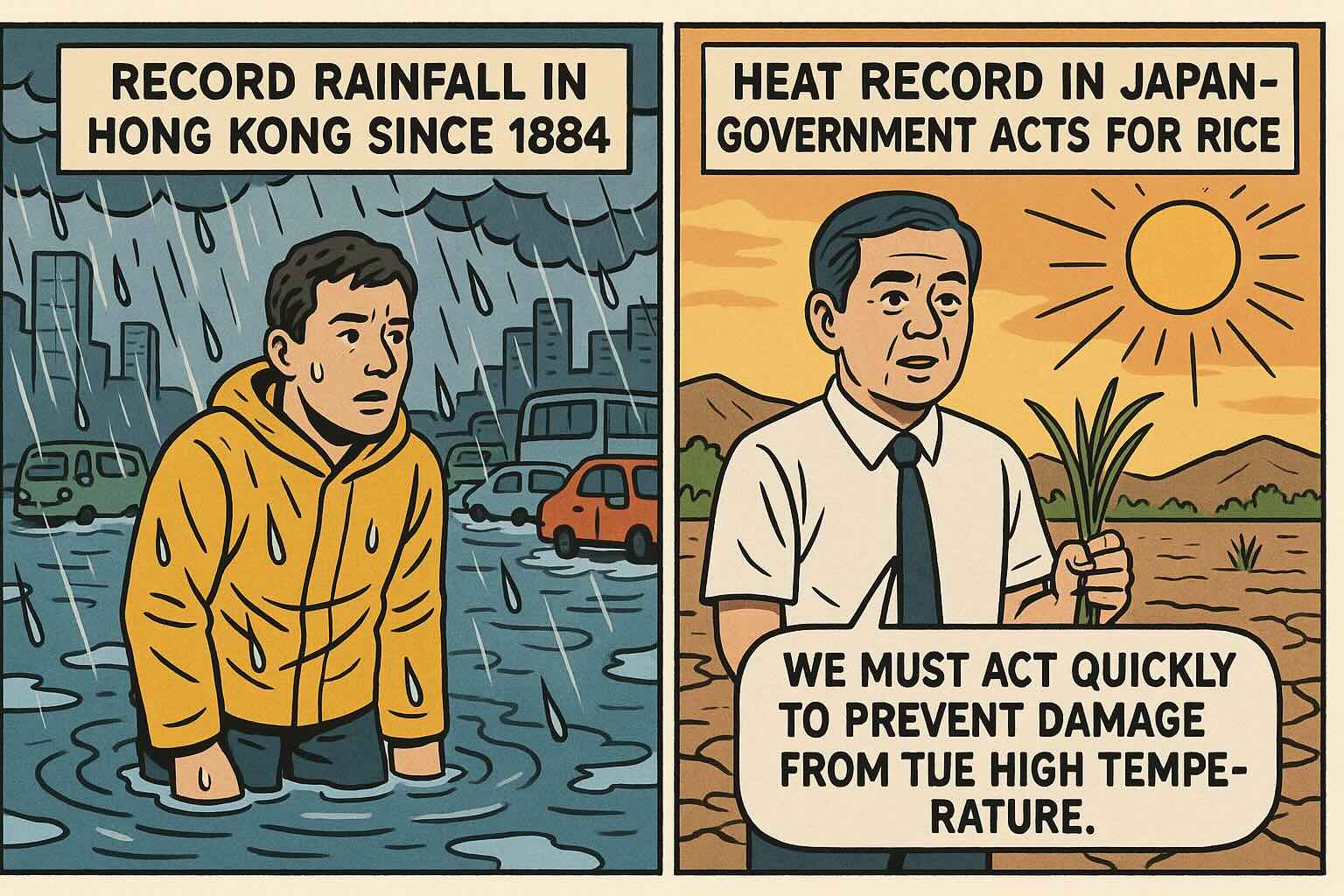
A catastrophic flash flood in Texas Hill Country over the July 4th weekend has left communities reeling and officials facing tough questions about America’s preparedness for extreme weather. Torrential rains nearly 14 inches fell in just five hours unleashed walls of water that swept through towns and summer camps, killing at least 82 people and leaving dozens more missing. Among the victims were many children attending a riverside camp, and grieving families are demanding to know if more could have been done to prevent such a massive tragedy.
Rescue crews search through debris along the Guadalupe River in Hunt, Texas, after the flash flood. The disaster struck overnight, catching many sleeping families off guard as floodwaters surged through camps and towns.
Rescue teams have been tirelessly combing through debris along the swollen Guadalupe River, searching for survivors and victims amid the wreckage. In one area, the river rose an astonishing 26 feet in just 45 minutes, obliterating homes and vehicles in its path. The flash flood struck in the pre-dawn darkness, and despite emergency alerts, many residents had little chance to escape the sudden deluge. Heart-wrenching tales of loss and survival have emerged from campers clinging to trees, to a camp director who sacrificed his life while rescuing children underscoring the human toll of this disaster.
The aftermath of the flooding in Kerrville, Texas: A large motor home was washed into a pile of debris at Louise Hays Park on the Guadalupe River. Scenes like this highlight the sheer force of the flash flood’s destructive power.
For those who witnessed the devastation firsthand, the scenes were almost surreal. In Kerrville’s Louise Hays Park, for example, floodwaters hurled a large RV onto the riverbank and piled it atop broken trees. Vehicles ended up wedged in treetops, bridges were clogged with uprooted trees, and entire neighborhoods lay submerged in muddy water. Texas Governor Greg Abbott declared disaster emergencies across 15 counties and mobilized more than a thousand responders, as volunteers joined officials in urgent search-and-rescue efforts amid the widespread destruction.
Central Texas is part of a region grimly nicknamed “Flash Flood Alley” because tropical moisture and slow-moving storms often collide over its hilly terrain. Yet even by those standards, the Independence Day weekend deluge was extraordinary. Meteorologists noted that nearly 14 inches of rain fell west of Austin in about five hours a burst of precipitation so rare it would only be expected roughly once in a thousand years under past climate conditions. This unprecedented rainfall, funneled over the rugged Hill Country, turned calm creeks into deadly torrents in a matter of minutes. Torrential downpours before dawn caused rivers to surge to record levels almost instantly; at one location, the Guadalupe River jumped 26 feet in under an hour, tearing away homes and campers as people slept.
Scientists point out that a confluence of factors supercharged the storm. The remnants of Tropical Storm Barry had recently made landfall in Mexico, and its circulation pulled in record amounts of moisture from the near-record warm Gulf of Mexico into central Texas. With a warmer atmosphere able to hold more water vapor, conditions were primed for an extreme cloudburst. In fact, weather balloons launched before the storm detected record-high atmospheric moisture over the region in line with the global trend of increasing atmospheric moisture content as the climate warms. Climate data show that heavy rainfall intensity in central Texas has been trending upward for decades, meaning today’s storms can unleash more rain than those of the past. The result in this case was a freak flash flood, supercharged by climate factors, hitting an area well known for flooding yet still overwhelmed by the ferocity of the event.
In the aftermath, attention has turned to the effectiveness of warning systems and preparedness measures. The National Weather Service (NWS) did issue multiple flash flood watches and warnings in the days and hours before the disaster. In fact, about an hour before the rivers suddenly swelled, the NWS office in Austin/San Antonio escalated to a rare Flash Flood Emergency the highest level of flood alert which automatically set off loud wireless emergency alerts on cell phones across the region. Despite these alerts, not everyone received the warning in time. The floods struck in the very early morning hours of July 4th, and many families were asleep or out of communication reach when the alarms went out. Some local officials initially suggested the disaster came with little warning, even though forecasters had flagged the flash flood threat well in advance.
One challenge was that early forecasts underestimated the sheer amount of rain that would fall. The first flood watch bulletins on Thursday had cautioned of 5 to 7 inches of torrential rain, but in reality more than double that volume drenched parts of the Hill Country. This highlights the inherent difficulties in predicting the precise severity and location of extreme downpours. Meteorologists compare it to trying to pinpoint a tornado’s strike zone a day ahead of time you can see the general threat coming, but exactly where and how much rain will fall is much harder to know in advance. With this flood, by the time the most intense rainfall became apparent, it was already unfolding in the dead of night, leaving a very narrow window for warnings to reach people on the ground.
The disaster has also reignited debate over whether cutbacks in federal weather agencies undermined the nation’s readiness for such extreme events. In an analysis for Sweden’s Dagens Nyheter newspaper, correspondent Karin Eriksson pointed out that the Trump administration pushed through budget cuts for U.S. weather services, resulting in some key positions remaining unfilled and she questioned whether those staffing gaps affected the flood crisis management. Indeed, at the time of the Texas flooding, local NWS offices in the region were operating without several senior staff members. One forecast office had vacancies in its meteorologist-in-charge and hydrologist roles, and another lacked a designated warning coordination meteorologist a key liaison for communicating warnings to local officials. Such vacancies put extra strain on the remaining staff, and observers note that the National Weather Service has struggled with chronic understaffing for years. Critics argue that hiring freezes and funding cuts in recent years have exacerbated these shortages.
Despite these challenges, forecasters on duty managed to cover the workload during this event. Extra personnel came in on overnight shifts and the NWS offices were still able to issue timely watches and warnings throughout the disaster. A preliminary review suggests that the specific Texas offices, even with their unfilled jobs, handled the situation as well as could be expected their vacancy rates were not drastically worse than historical norms, and they did not experience the data outages (like missed weather balloon launches) that have hit some other regions. “Despite funding cuts and widespread staffing shortages implemented by the Trump administration, NWS forecasters in Texas provided a series of watches and warnings in the days and hours leading up to Friday’s flooding disaster,” meteorologist Eric Holthaus noted, crediting the dedication of front-line forecasters.
However, experts caution that chronic underfunding can hinder improvements in forecasting that might be crucial for future events. Notably, the Trump administration’s cuts particularly affected the National Oceanic and Atmospheric Administration’s Environmental Modeling Center, the unit tasked with improving advanced weather prediction models. Setbacks in developing better models mean less lead time and accuracy in forecasts of unusually complex, localized phenomena like the Texas flash flood. In other words, while the weather service’s field offices did their best and largely succeeded in warning about this disaster, broader investments in forecasting technology, staffing and research remain essential to keep pace with a changing climate.
This flood has become a sobering example of the challenges posed by extreme weather in a warming world. “It’s clear that this was a complex, compound tragedy of a type that climate warming is making more frequent,” Holthaus wrote in The Guardian, reflecting a growing consensus among scientists that climate change is loading the dice for such disasters. Across the United States and the globe, record-breaking downpours, floods, heatwaves and storms are testing the limits of infrastructure and emergency planning. Even regions like central Texas which are no strangers to flooding are finding it difficult to anticipate just how severe these events can get.
The Texas catastrophe has amplified calls for bolstering preparedness on multiple fronts. Advocates urge improvements to early warning systems (so alerts reach everyone in harm’s way), investments in resilient infrastructure (like dams, levees, and updated flood maps), and aggressive action to address climate change itself. For the families who lost loved ones and the survivors who must rebuild, these debates are far more than policy questions they are personal. The hope is that the lessons learned from this tragedy will spur meaningful changes, so that the next time nature unleashes its fury, communities will be better equipped to withstand it and fewer lives will be at risk.
Sources:
Karin Eriksson, Dagens Nyheter analysis of Texas flooding and preparedness omni.se
Eric Holthaus, The Guardian analysis: “Texas floods reveal limitations of disaster forecasting under climate crisis”theguardian.com
Oliver Milman et al., The Guardian news report on Texas flood recovery theguardian.com
Monica Danielle, AccuWeather report on Texas flooding and impacts accuweather.com
Briahn Hawkins, FOX 26 Houston report on Camp Mystic and flood aftermath fox26houston.com
Author
Sammy Salmela is a contributor to BestCityIndex with expertise in urban development and global city trends.
Stay updated with our latest insights and city rankings.

Introduction:The aroma of aged wheels, bubbling fondue, and freshly baked bread for cheese lovers, Europe is a true paradise. Here are five cities where cheese...

Date: 5 August 2025Source: AFP, Reuters, Local Weather AuthoritiesReading Time: 3 minutesIntroductionIn just one week, Asia has faced two stark climate...

Moving to Europe: Pros and Cons by Country for Work, Retirement, Education & Lifestyle Part 1.Moving from the United States to Europe is an exciting...


